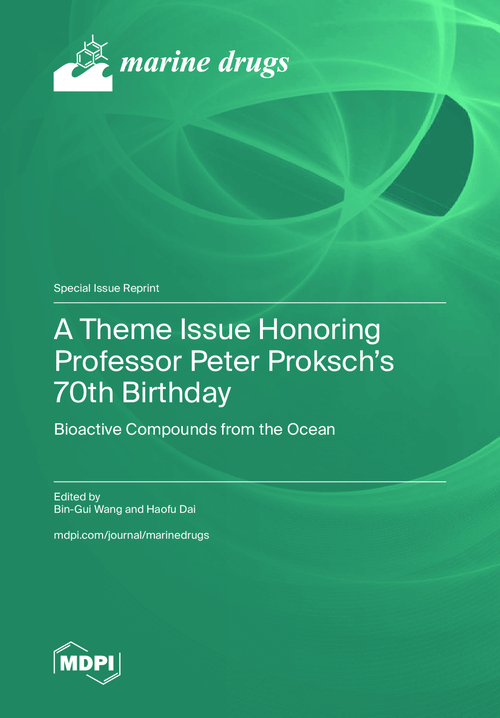A Theme Issue Honoring Professor Peter Proksch's 70th Birthday: Bioactive Compounds from the Ocean

Download Url(s)
https://mdpi.com/books/pdfview/book/9665Contributor(s)
Wang, Bin-Gui (editor)
Dai, Haofu (editor)
Language
EnglishAbstract
The following commemorative Special Issue on bioactive compounds from the ocean is in honor of Prof. Dr. Peter Proksch on his 70th birthday. Prof. Dr. Proksch is an internationally recognized scientist in research on both terrestrial and marine natural products. Prof. Dr. Proksch worked with terrestrial plants in the early stage of his career and started to work on marine natural products some thirty years ago. He once said, “When I started to work on marine natural products, I was attracted to this fascinating field of science by the exotic environment, the colorful shapes of (mostly) marine invertebrates, and their complex ecological interactions”. In parallel to marine macroorganisms, he soon embarked on studying natural products from marine-derived microorganisms, discovering a huge amount of biodiversity and highly unusual and complex microbial natural products. The topics of this Special Issue include but are not limited to the following: The isolation, structural elucidation, and bioactivity of new molecules from marine organisms; The characterization of proteins, enzymes, and saccharides from marine organisms; The biosynthesis of bioactive compounds from marine organisms; The design, synthesis, modification, and structure–activity relationship of bioactive compounds from marine organisms; The pharmacological mechanisms of bioactive compounds from marine organisms.
Keywords
marine fungus; Penicillium copticola; copteremophilanes A–J; structure elucidation; antitumor activity; neuroprotection; soft coral; Sarcophyton trocheliophorum; capnosane; cembrane; absolute configuration; anti-tumor activity; marine-derived fungus; Penicillium sclerotiorum; azaphilones; anti-inflammatory activity; Aspergillus insulicola; phenolic compounds; ECD calculations; α-glucosidase inhibition; Aspergillus chevalieri; deep-sea cold seep; indole diketopiperazine; antibacterial activity; Aspergillus sclerotiorum; secondary metabolite; alkaloid; sclerotioloids; mangrove sediment-derived fungi; polyketide; stachylines; biological activity; Hamigera avellanea; Aspergillaceae; marine sponge-associated fungus; pentaketides; dihydrochromone; 5-p-hydroxy-2-pyridone; anti-plant pathogenic fungal activity; Trichoderma; lipid; antifungal activity; antimicroalgal activity; fusarin derivatives; Penicillium steckii; marine algicolous fungus; deep-sea; fungus; Penicillium citrinum; polyketides; anti-osteoporosis; anti-inflammation; Aspergillus; pyridazinone-N-oxide hybrid; sterigmatocystin; antitumor; cell cycle arrest; mangrove endophytic fungus; Phomopsis sp.; cytosporone; anti-inflammatory; indole diketopiperazine alkaloids; prenylation; genome sequencing; X-ray diffraction; pancreatic cancer; pancreatic ductal adenocarcinoma; mangrove endophytic fungi; Phomopsis asparagi; co-culture; metabolomics; molecular network; xanthone dimersWebshop link
https://mdpi.com/books/pdfview ...ISBN
9783725817771, 9783725817788Publisher website
www.mdpi.com/booksPublication date and place
2024Classification
Medicine and Nursing
Pharmacology

